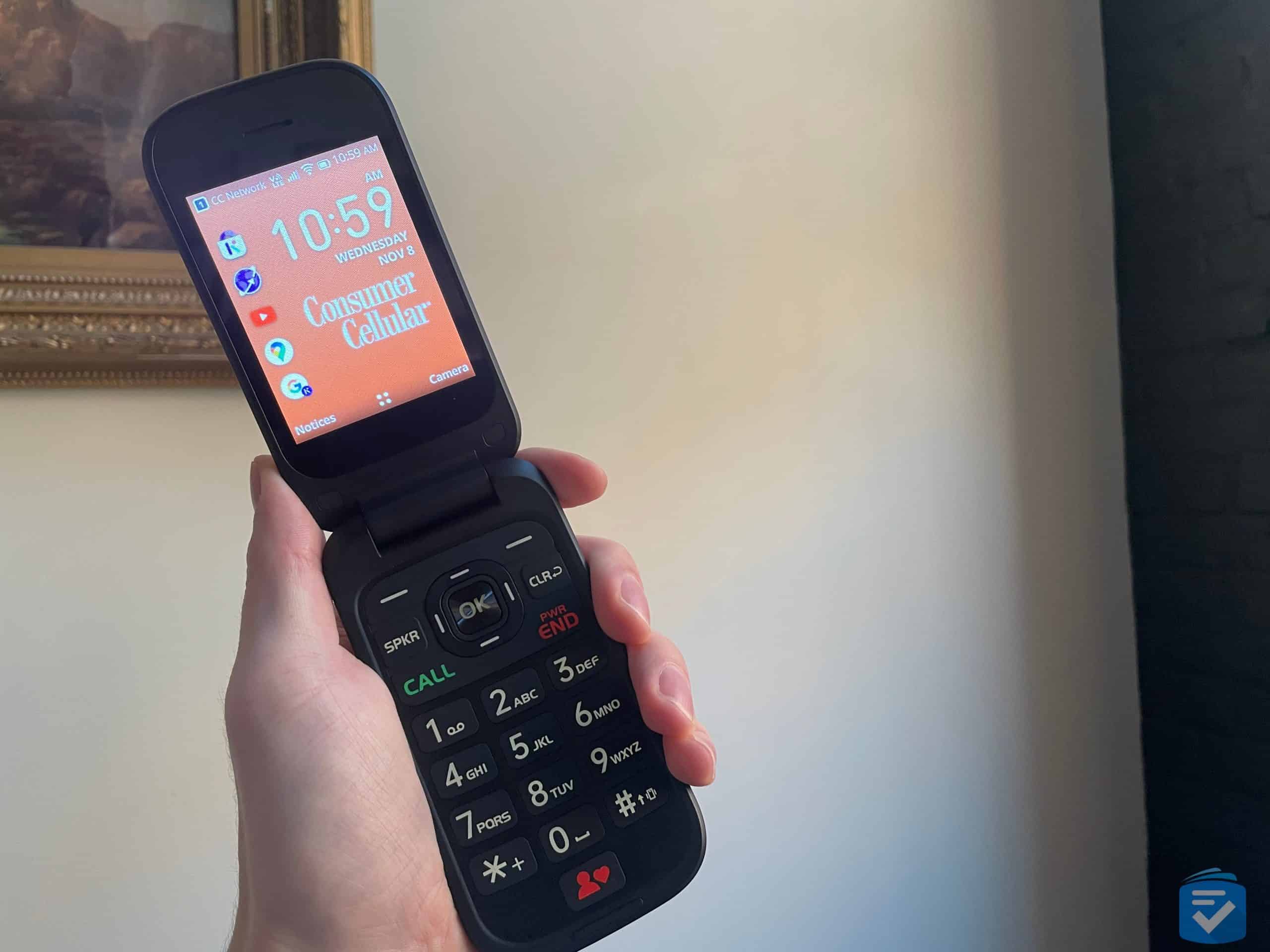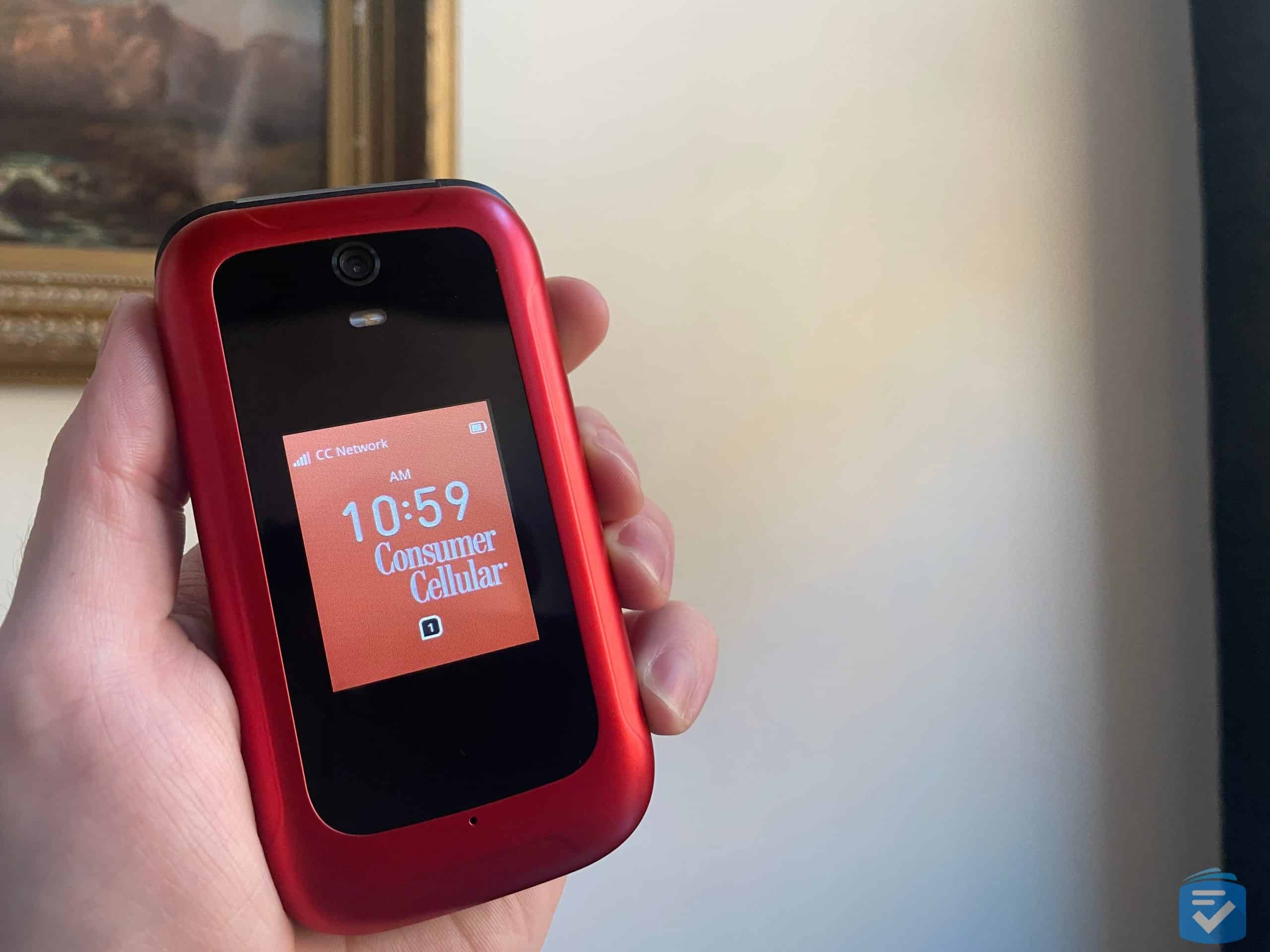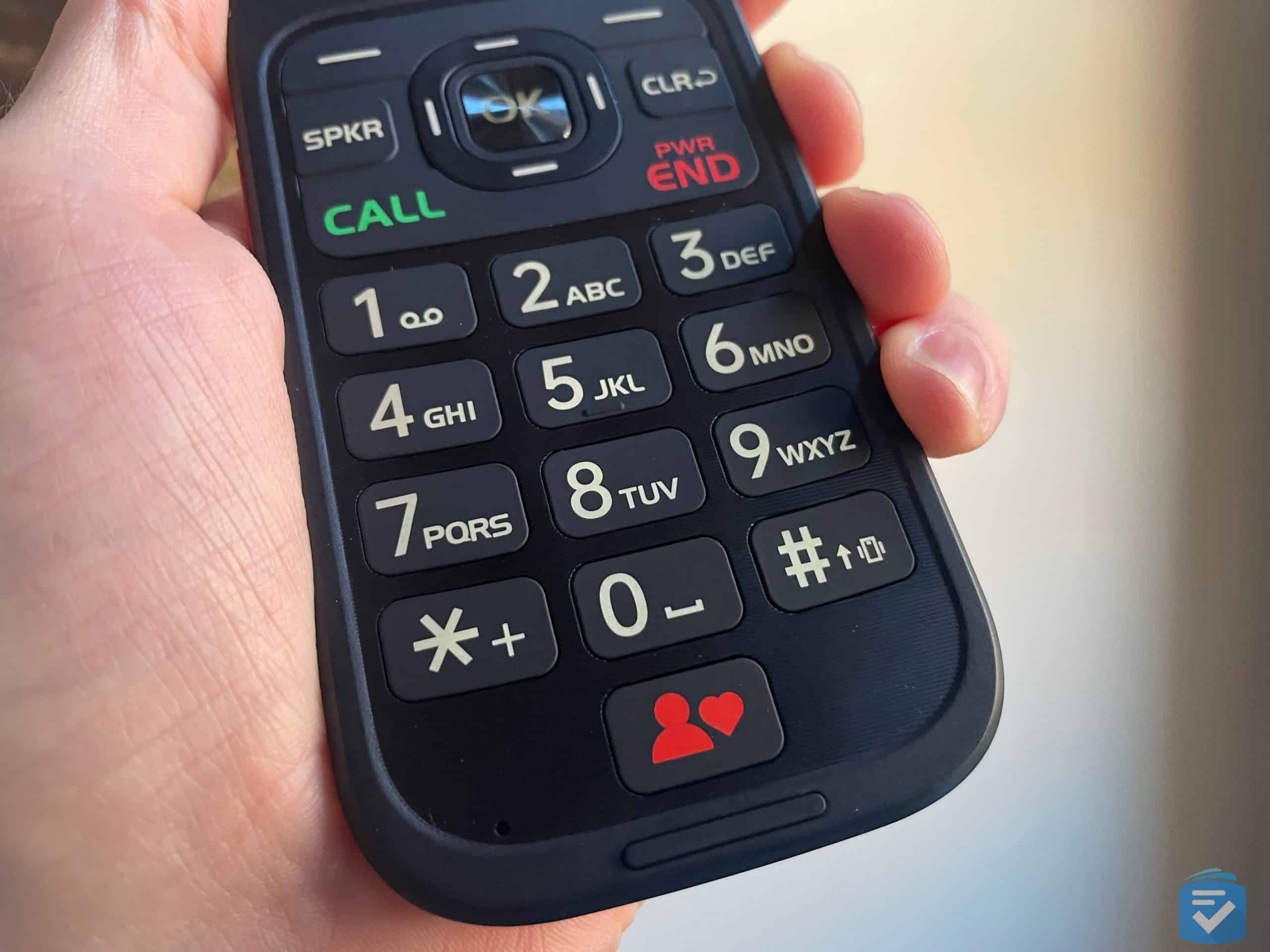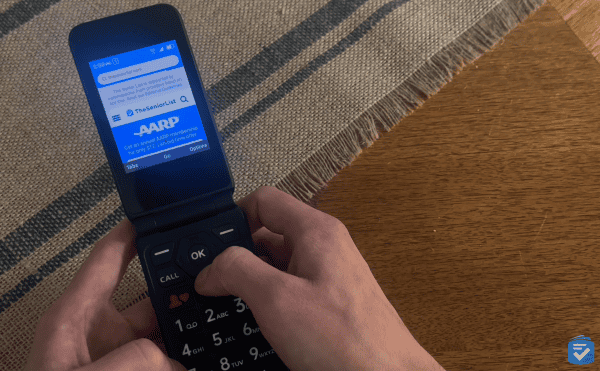
Consumer Cellular Iris Easy Flip Review

If you’re purchasing cellular service from Consumer Cellular, you’ll find a variety of smartphone options to pair with your plan. As of this writing, the provider offers the latest smartphones from Apple, Samsung and Motorola. Much more limited is the provider’s selection of simple phones.
Consumer Cellular offers one flip phone, the Iris Easy Flip, which is one of our top-rated simple phones. The Iris Easy Flip stands out with its dual 2.8-inch displays, selfie-capable camera and massive storage expansion options up to 128GB. All of those features come at an incredibly competitive price of $59. Consumer Cellular also allows you to bring your own phone to their network, however, raising the question: Is the Iris Easy Flip worth it?
In this review of the Iris Easy Flip, we’ll take a closer look at the phone. We’ll walk through the process of activating the phone, and test each of its features, from making calls to taking photos to browsing the internet.
Did You Know: Curious how the Iris Easy Flip compares to other devices? Read our rundown of this year’s best flip phones.
Iris Easy Flip Pros and Cons
Iris Flip Pros
- Dual displays: The Iris Easy Flip features large 2.8-inch internal and external screens, allowing you to see incoming call info, notifications and alarms without opening the phone.
- Selfie capability: Unlike many flip phones, you can take selfies with the phone closed by using the dedicated camera button and external display.
- Simplified interface: The Easy Flip features a user-friendly interface with large icons for the most common applications.
- Excellent hearing aid compatibility: The phone is rated M4/T4, the highest rating for hearing aid compatibility.
- Long battery life: The 2000 mAh battery provides seven hours of talk time and up to 14 days on standby.
- Affordable: At just $59, it’s one of the most budget-friendly flip phones on the market.
Pro Tip: Not so keen on Consumer Cellular? Read our rundown of the best phone plans for seniors to find options from $10 per month.
What We Didn’t Like About Consumer Cellular IRIS Easy Flip
- Subpar camera: Keeping in tradition with flip phones of the past, the Iris Easy Flip’s 5MP camera captured hazy and grainy images in our test photos.
- Limited apps: The Iris Flip has an internet browser, but we found it incredibly difficult to use. If you want a smooth internet browser, check out one of our favorite smartphones.
- Cumbersome texting: Traditional T9 input makes texting time-consuming, especially without voice-to-text functionality.
Iris Flip Video Review
Watch this video to see the Iris Easy Flip in action, including its voice commands and app functionality.
>> Further reading: The Best Smartphones for Seniors
Did You Know: Pew Research found that roughly 61% of seniors own a smartphone, indicating that, even among older generations, the desire for simplified flip phones may be waning.
Purchasing the Iris Easy Flip
The Iris Easy Flip is currently available from various brick-and-mortar locations (including Target and Walmart), but we chose to purchase the phone from Consumer Cellular’s website. The phone cost $59 plus $12 for shipping. Prices are similar if you decide to purchase the phone in-store.
>> Further reading: Jitterbug Smart4 Phone Review
Iris Easy Flip Plans
When paired with one of Consumer Cellular’s plans, we could pay as little as $20 per month for unlimited talk, unlimited texts and 1GB of data.
Consumer Cellular offers plans with more data, but most Iris Easy Flip users wouldn’t be doing too many data-heavy tasks, such as streaming video. The Iris Easy Flip also supports Wi-Fi, so we didn’t use any data allowance when we used the internet in our testing environment.
One thing to note with Consumer Cellular is that their monthly prices, as stated on their website, include a discount for enrolling in the auto-pay option. With auto-pay enabled, your payment method will automatically be charged each month.
If you opt out of the auto-pay option, your monthly bill will be $5 higher, regardless of which plan you choose.
Iris Easy Flip Activation

Once we received our Iris Easy Flip, we unboxed the phone and found the following:
- 1 Iris Easy Flip phone
- 1 USB-A to USB-C cable
- 1 USB-A wall charger
- Documentation
To activate our phone, we simply had to charge it and call Consumer Cellular’s customer-service line. We also could have activated it by scanning the QR code on our Iris Easy Flip’s user manual. Either option will get your phone operational in a matter of minutes.
Iris Flip Design

The Iris Easy Flip combines classic flip phone familiarity with modern improvements. On the phone’s exterior, you have a large 2.8-inch external display that shows incoming call information, notifications of missed calls, messages and alarms — all without needing to open the phone. The phone measures just 2.24 inches wide, 4.34 inches high and 0.79 inches deep, so it will fit comfortably in your hand.

On the inside of the phone, you’ll find the simplified user interface with large icons for the most common applications. The backlit keypad features large letters for easy reading, and the phone includes a quick-dial “Favorites” key for instant access to your most important contacts.
The dedicated camera button allows you to take selfies with the phone closed. That isn’t ideal, but it’s still better than no selfie camera at all.
>> Read more: The Best Phones With Big Buttons
Overall, the Iris Easy Flip delivers on its promise of “easy functionality and elegance,” providing a no-fuss device that does exactly what users need.
FYI: In past years, flip phone use has grown among younger generations, indicating that this nearly-forgotten technology might be making a resurgence.
Testing the Iris Easy Flip

We first made a series of calls to test the Iris Easy Flip. In-home and on the go, we found that all our calls connected easily, with clear audio on both ends. The 4G LTE connectivity provided reliable service throughout our testing.
Keep in mind that we live in a city — Pawtucket, Rhode Island, to be specific — so we had full coverage from Consumer Cellular’s 4G LTE network. If you live in a more rural area, you’ll want to look at Consumer Cellular’s website to see if they cover your area.
>> Read more: Consumer Cellular Review
The Iris Easy Flip is rated M4/T4 for hearing aid compatibility, the highest rating available. That means users with hearing aids should experience minimal interference when using the phone.
Texting Experience
During our testing, the texting experience on the Iris Easy Flip was somewhat cumbersome, particularly for longer messages. The phone uses traditional T9 predictive text input, which requires multiple key presses for each letter. For example, typing “hello” requires pressing 4-4 (h), 3-3 (e), 5-5-5 (l), 5-5-5 (l), 6-6-6 (o).
The keypad features large, easy-to-read letters, but composing anything beyond brief messages proved time-consuming. We missed the convenience of phones with full QWERTY keyboards or voice-to-text capabilities. For users who primarily text short responses such as “OK” or “On my way,” it won’t be a significant issue. Those who enjoy more extended text conversations, however, may find the traditional keypad input frustrating.
The lack of voice-to-text functionality particularly stood out during our testing. Many competing flip phones now include this feature, which allows users to speak their message and convert it to text simply. For older adults or those with arthritis who may struggle with repetitive button pressing, that missing feature could be a significant drawback.
That said, the large buttons and clear display make it easier to see what you’re typing, and the predictive text improves somewhat as it learns your commonly used words. This limitation may not be a deal-breaker for users who primarily make calls rather than text.
FYI: If voice-to-text sounds useful, check out our guide to the best voice-activated phones for seniors.
Storage
One of the standout features of the Iris Easy Flip is its storage capacity. The phone comes with 8GB of internal storage, but it can be expanded up to 128GB with a microSD card (sold separately). That is up to four times more external storage than many other flip phones, which max out at 32GB. The extra space is perfect for storing photos of grandchildren, music or other files.
Camera
The Iris Easy Flip features a 5MP camera with some unique capabilities for a flip phone. Most notably, it includes a screen flash for better low-light photos and a dedicated selfie mode. The selfie feature is particularly innovative; you can take selfies with the phone closed using the external display as a viewfinder.
To take a selfie, simply close the phone, press the dedicated camera button to activate the camera, frame your shot using the external display and press the camera button again to capture. You can even switch to video mode using the volume-up key.
The 5MP camera won’t compete with modern smartphones, but it’s perfectly adequate for capturing memories of grandchildren, documenting recipes or taking quick snapshots to share with family.
Iris Easy Flip vs. Jitterbug Flip2
| x | Iris Easy Flip | Jitterbug Flip2 |
|---|---|---|
| Cost | $59 | $79.99 |
| Battery life | 7 hours of talk or 14 days standby | 12 hours of talk time |
| External display | Yes (2.8 inches) | Yes (smaller) |
| Storage expansion | Up to 128GB | Limited |
| Hearing aid rating | M4/T4 | M4/T3 |
| Selfie mode | Yes | No |
| Safety features | Emergency contacts group | Yes (more extensive) |
The Iris Easy Flip and the Jitterbug Flip2 are two of the most popular flip phones on the market. Both phones are designed for seniors and people who want a simple, easy-to-use phone. However, there are some key differences between the two phones.
Price
The Iris Easy Flip has a significant price advantage at $59, compared to the Jitterbug Flip2’s $79.99 price tag.
Features
The Iris Easy Flip offers several unique features, including dual 2.8-inch displays, selfie capability with the phone closed and massive storage expansion up to 128GB. It also has the highest hearing aid compatibility rating at M4/T4.
The Jitterbug Flip2 counters with more extensive safety features, including nurse hotlines and 24/7 urgent-response calling features, although they cost extra.
Which Is Better?
For most users looking for an affordable, easy-to-use flip phone with modern conveniences, the Iris Easy Flip offers exceptional value at $59. Its dual displays, selfie capability and massive storage expansion stand out in the flip phone market.
If safety features are your primary concern and you’re willing to pay more, however, the Jitterbug Flip2 may be worth considering. To learn more about the phone’s costs and features, read our full Jitterbug Flip2 review.
Fun Fact: A study of nearly 200,000 adults found that roughly 11 percent of them reported impairments in daily activities due to the overuse of the internet, gaming or smartphones. Studies like that underscore the potential benefits of simplified devices like flip phones.
Our Verdict
Overall, we were very impressed with the Iris Easy Flip. At just $59, it delivers exceptional value with features typically found in more expensive phones. Plus, the dual displays, selfie capability and storage expansion set it apart from other flip phones in this price range.
The simplified user interface with large icons, backlit keypad with large letters and M4/T4 hearing aid compatibility make it an excellent choice for older adults or anyone seeking a straightforward, reliable phone. The modern connectivity options, including 4G LTE, Wi-Fi, Bluetooth and USB-C charging, ensure that it won’t feel outdated.
We’d definitely recommend the Iris Easy Flip to anyone looking for an affordable, easy-to-use flip phone that doesn’t sacrifice essential features.
Frequently Asked Questions
-
Is the Iris Easy Flip phone a smartphone?
No, the Iris Easy Flip is a flip phone with a simplified user interface and large icons for common applications. It includes internet browsing capabilities, but they’re limited.
-
What carrier does the Iris Easy Flip phone use?
The Iris Easy Flip uses Consumer Cellular and can be paired with plans starting at $20 per month.
-
How long does the Iris Easy Flip’s battery last?
The 2000 mAh battery provides up to seven hours of talk time and up to 14 days on standby.
-
Can you take selfies with the Iris Easy Flip?
Yes! The Iris Easy Flip has a unique selfie mode that lets you take photos with the phone closed using the external display as a viewfinder.
-
How much storage does the Iris Easy Flip have?
The phone has 8GB of internal storage, which can be expanded to 128GB with a microSD card (sold separately).








